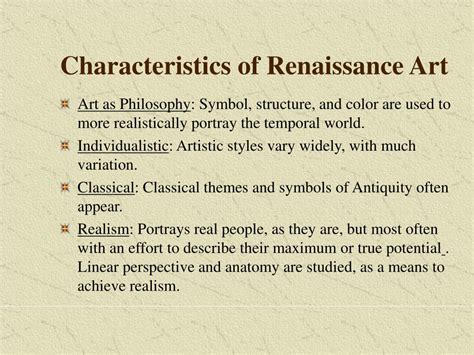The Renaissance, a period of cultural rebirth and innovation in Europe, had a profound impact on art, leading to the development of new styles and techniques that would endure for centuries to come. Numerous key characteristics emerged as defining features of Renaissance art, but which sentence best encapsulates its essence?

A Comprehensive Overview of Renaissance Art’s Characteristics
Renaissance art was characterized by a departure from the stylized and otherworldly depictions of the medieval era. Instead, artists sought to portray the human form and the world around them with greater naturalism and accuracy. This pursuit of realism extended to both the subject matter and the techniques employed.
-
Humanism and the Celebration of the Individual: Renaissance artists focused on depicting the human form, exploring anatomy, proportion, and expression to capture the complexities of the individual.
-
Realism and Naturalism: Artists strove to accurately depict the world around them, using techniques such as linear perspective, chiaroscuro, and sfumato to create an illusion of depth and realism.
-
Classical Influences: Renaissance artists drew inspiration from classical Greek and Roman art, incorporating elements such as balance, symmetry, and idealization into their own works.
-
Scientific Inquiry and Observation: Artists engaged in scientific inquiry and observation to understand human anatomy and the natural world, which informed their artistic practices.
-
Linear Perspective: This technique created the illusion of depth on a two-dimensional surface, enhancing the realism of Renaissance paintings and drawings.
-
Sfumato: Leonardo da Vinci’s innovative technique involved blending colors and tones without noticeable lines, creating a soft, ethereal effect.
-
Patronage and the Rise of the Medici: Wealthy patrons, particularly the Medici family, played a pivotal role in the flourishing of Renaissance art, commissioning works from renowned artists.
-
Influence on Western Art: Renaissance art laid the foundation for Western art, its principles and techniques influencing subsequent artistic movements.
Which sentence best describes the characteristics of Renaissance art?
A. Renaissance art celebrated humanism and realism, depicting the individual with unprecedented accuracy.
B. Renaissance artists drew heavily from classical influences, incorporating balance and idealization into their work.
C. Renaissance art was highly influenced by scientific inquiry and observation, which informed the depiction of the natural world.
D. Renaissance art employed innovative techniques, such as linear perspective and sfumato, to enhance the illusion of depth and realism.
The correct answer is:
A. Renaissance art celebrated humanism and realism, depicting the individual with unprecedented accuracy.
This sentence encapsulates the essence of Renaissance art by highlighting its focus on humanism, realism, and the accurate portrayal of the individual. Humanism, a central theme in Renaissance art, celebrates the uniqueness and potential of the individual, while realism emphasizes the accurate depiction of the human form and the world around it. Together, these characteristics define the spirit of the Renaissance artistic movement.
